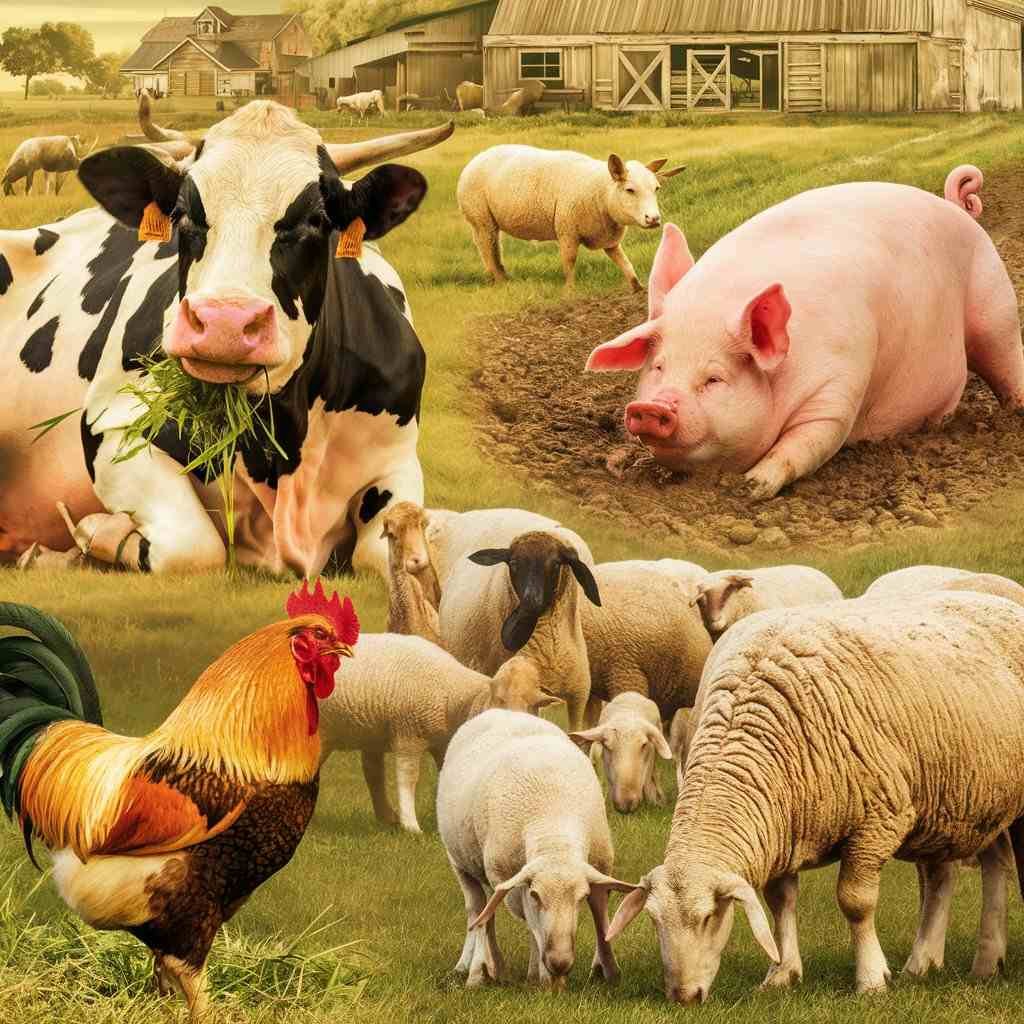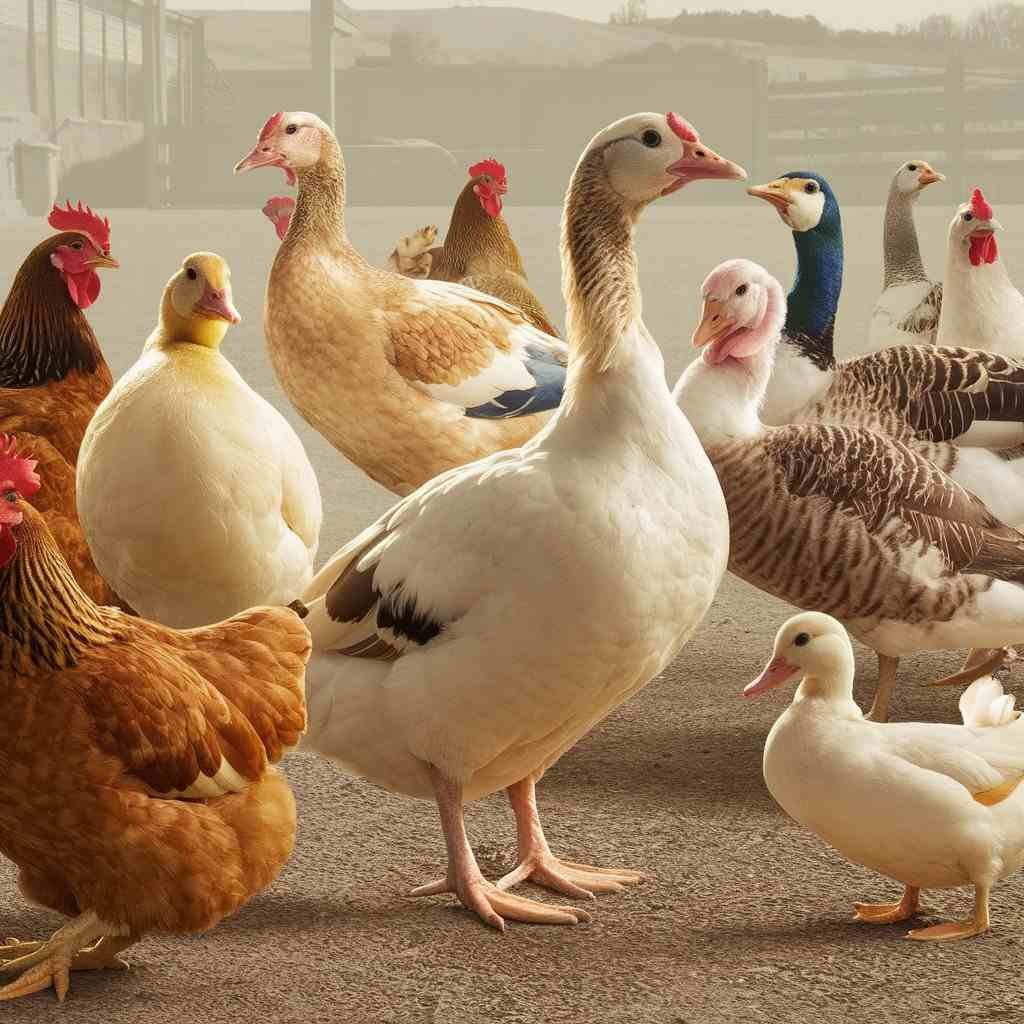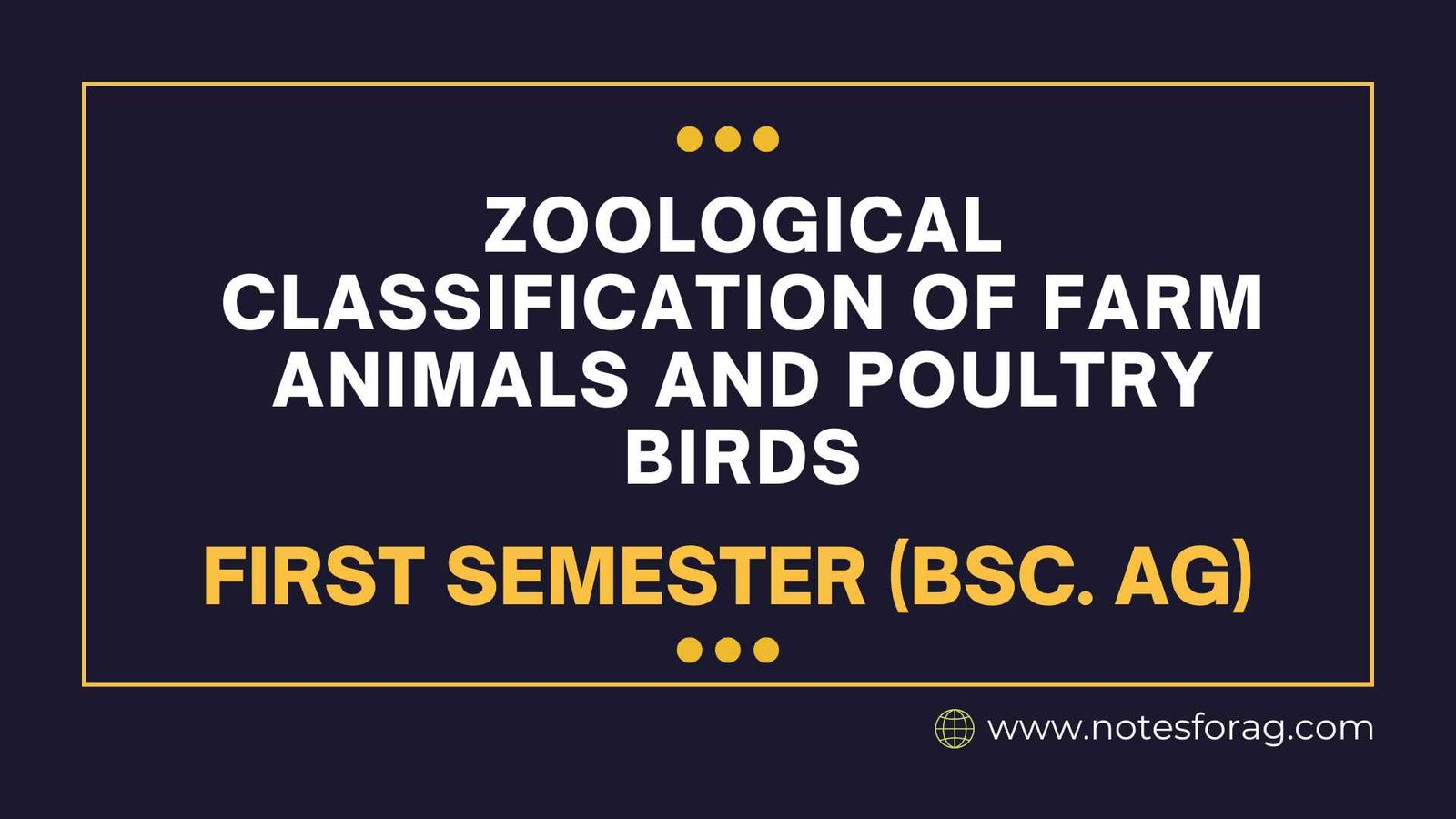Farm animals and poultry birds play a vital role in agriculture by providing necessary goods like meat, milk, eggs, wool, and leather. Poultry birds, such as chickens, ducks, turkeys, and geese, are raised mainly for their meat and eggs, whereas farm animals, such as cattle, sheep, goats, pigs, and horses, are raised for a variety of resources and services. In order to maintain rural lives, guarantee food security, and boost the agricultural economy, both groups are essential. To ensure animal welfare and maximize productivity, Farm animals and poultry birds must be managed and cared for effectively.
Table of Contents
Farm Animals

Farm animals are domesticated animals raised in an agricultural environment for the production of goods including meat, milk, eggs, wool, and leather. They are cultivated for their nutritional and economic value to human society and comprise animals such as cattle, sheep, goats, pigs, horses, and poultry. These farm animals are vital to agriculture and support global food security, rural economies, and cultural heritage. Sustainable and moral farming methods are ensured by providing farm animals with the proper management and care, which is essential for their general wellbeing, productivity, and health.
Poultry Birds

Poultry birds are domesticated bird raised in agricultural environments for their meat, eggs, and feathers. Ducks, geese, turkeys, and hens are some of these birds. They are maintained because of their important roles in the agricultural economy and food production. Poultry farming is an important source of protein for human consumption and contributes significantly to the global food production process. The sector uses a variety of production systems, each with its own set of welfare issues and management techniques, such as traditional cage systems, free-range systems, and organic approaches.
The zoological classification of Farm animals and poultry birds are given below:
Zoological classification of farm animals
The zoological classification of farm animals organizes them into hierarchical categories based on their biological characteristics and evolutionary relationships. Here’s a detailed breakdown:
1. Cattle (Bos taurus)
Cattle are classified as Bos taurus in the animal kingdom, Chordata group, Mammalia class, Artiodactyla order, and Bovidae family.
- Kingdom: Animalia
- Phylum: Chordata
- Class: Mammalia
- Order: Artiodactyla
- Family: Bovidae
- Genus: Bos
- Species: B. taurus
2. Sheep (Ovis aries)
Sheep belong to the Animalia kingdom, Chordata phylum, Mammalia class, Artiodactyla order, and Bovidae family.
- Kingdom: Animalia
- Phylum: Chordata
- Class: Mammalia
- Order: Artiodactyla
- Family: Bovidae
- Genus: Ovis
- Species: O. aries
3. Goats (Capra aegagrus hircus)
Goats are classified as Capra aegagrus hircus within the Animalia kingdom, Chordata phylum, Mammalia class, Artiodactyla order, and Bovidae family.
- Kingdom: Animalia
- Phylum: Chordata
- Class: Mammalia
- Order: Artiodactyla
- Family: Bovidae
- Genus: Capra
- Species: C. aegagrus hircus
4. Pigs (Sus scrofa domesticus)
Pigs are classified as Sus scrofa domesticus within the Animalia kingdom, Chordata phylum, Mammalia class, Artiodactyla order, and Suidae family.
- Kingdom: Animalia
- Phylum: Chordata
- Class: Mammalia
- Order: Artiodactyla
- Family: Suidae
- Genus: Sus
- Species: S. scrofa domesticus
5. Horses (Equus ferus caballus)
Horses belong to the Animalia kingdom, Chordata phylum, Mammalia class, Perissodactyla order, and Equidae family.
- Kingdom: Animalia
- Phylum: Chordata
- Class: Mammalia
- Order: Perissodactyla
- Family: Equidae
- Genus: Equus
- Species: E. ferus caballus
6. Donkeys (Equus africanus asinus)
Donkeys belong to the Animalia kingdom, Chordata phylum, Mammalia class, Perissodactyla order, and Equidae family.
- Kingdom: Animalia
- Phylum: Chordata
- Class: Mammalia
- Order: Perissodactyla
- Family: Equidae
- Genus: Equus
- Species: E. africanus asinus
7. Water Buffalo (Bubalus bubalis)
Water buffalo belong to the Animalia kingdom, Chordata phylum, Mammalia class, Artiodactyla order, and Bovidae family.
- Kingdom: Animalia
- Phylum: Chordata
- Class: Mammalia
- Order: Artiodactyla
- Family: Bovidae
- Genus: Bubalus
- Species: B. bubalis
8. Camels (Camelus dromedarius and Camelus bactrianus)
Camels belong to the Animalia kingdom, Chordata phylum, Mammalia class, Artiodactyla order, and Camelidae family.
- Kingdom: Animalia
- Phylum: Chordata
- Class: Mammalia
- Order: Artiodactyla
- Family: Camelidae
- Genus: Camelus
- Species: C. dromedarius (Dromedary or one-humped camel), C. bactrianus (Bactrian or two-humped camel)
Zoological classification of poultry birds
The zoological classification of poultry birds organizes them into hierarchical categories based on their biological characteristics and evolutionary relationships. Here’s a detailed breakdown:
1. Chickens (Gallus gallus domesticus)
Chickens belong to the Animalia kingdom, Chordata phylum, Aves class, Galliformes order, and Phasianidae family.
- Kingdom: Animalia
- Phylum: Chordata
- Class: Aves
- Order: Galliformes
- Family: Phasianidae
- Genus: Gallus
- Species: G. gallus
- Subspecies: G. g. domesticus
2. Ducks (Anas platyrhynchos domesticus)
Ducks belong to the Animalia kingdom, Chordata phylum, Aves class, Anseriformes order, and Anatidae family.
- Kingdom: Animalia
- Phylum: Chordata
- Class: Aves
- Order: Anseriformes
- Family: Anatidae
- Genus: Anas
- Species: A. platyrhynchos
- Subspecies: A. p. domesticus
3. Turkeys (Meleagris gallopavo)
Turkeys belong to the Animalia kingdom, Chordata phylum, Aves class, Galliformes order, and Phasianidae family.
- Kingdom: Animalia
- Phylum: Chordata
- Class: Aves
- Order: Galliformes
- Family: Phasianidae
- Genus: Meleagris
- Species: M. gallopavo
4. Geese (Anser anser domesticus)
Geese belong to the Animalia kingdom, Chordata phylum, Aves class, Anseriformes order, and Anatidae family.
- Kingdom: Animalia
- Phylum: Chordata
- Class: Aves
- Order: Anseriformes
- Family: Anatidae
- Genus: Anser
- Species: A. anser
- Subspecies: A. a. domesticus
5. Quail (Coturnix japonica)
Quails belong to the Animalia kingdom, Chordata phylum, Aves class, Galliformes order, and Phasianidae family.
- Kingdom: Animalia
- Phylum: Chordata
- Class: Aves
- Order: Galliformes
- Family: Phasianidae
- Genus: Coturnix
- Species: C. japonica
6. Pigeons (Columba livia domestica)
Pigeons belong to the Animalia kingdom, Chordata phylum, Aves class, Columbiformes order, and Columbidae family.
- Kingdom: Animalia
- Phylum: Chordata
- Class: Aves
- Order: Columbiformes
- Family: Columbidae
- Genus: Columba
- Species: C. livia
- Subspecies: C. l. domestica
Conclusion: Farm animals and poultry birds are classified zoologically according to their biological and evolutionary traits. Cattle (Bos taurus), sheep (Ovis aries), goats (Capra aegagrus hircus), pigs (Sus scrofa domesticus), and horses (Equus ferus caballus) are examples of farm animals. These species are categorized under particular orders and families within the Kingdom Animalia, Phylum Chordata, and Class Mammalia. Animalia, Phylum Chordata, Class Aves, and Kingdom Animalia are the classifications for poultry birds, which include chickens (Gallus gallus domesticus), ducks (Anas platyrhynchos domesticus), turkeys (Meleagris gallopavo), and geese (Anser anser domesticus). Understanding the Farm animals and poultry birds management, breeding, and conservation is aided by these classifications.
Frequently Asked Question(FAQ)
Why is zoological classification important for farm animals and poultry birds?
It helps with the efficient management, breeding, medical treatment, and conservation of various species by offering a methodical approach to comprehending the biological and evolutionary relationships between them.
How does zoological classification help farmers?
It helps farmers better understand the unique requirements and traits of each species, optimize breeding programs, raise healthier and more productive animals, and effectively manage resources.
Can the classification of farm animals and poultry birds change over time?
Yes, new scientific findings and developments in the fields of genetics and evolution may cause a reclassification of species as well as a better knowledge of them.
Related Articles

